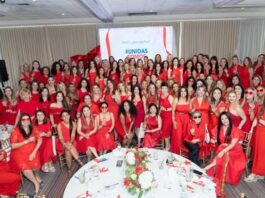VISION G Cupé en LACMA (English below)
Hyundai Motor America dio a conocer el Concepto “Vision G” Coupe en el Los Angeles County Museum of Art (LACMA). El concepto fue descrito como la inspiración de Hyundai para su familia de futuros productos de primera que prometen lujo, desempeño y estilo con el valor y la responsabilidad que constituyen la base de la marca Hyundai.
“El concepto fue diseñado con un aporte coordinado de los estudios de diseño de Hyundai situados alrededor del mundo, pero fue dirigido por nuestro equipo de aquí, de Estados Unidos”, dijo Peter Schreyer, Presidente y Director de Diseño en Hyundai. “El diseño es nuestra interpretación de la idea de que Hyundai respira en todos sus vehículos – un ADN que equilibra el diseño y el desempeño con la idea de que no se necesita exagerar en términos de brillo y detalles lujosos estereotipados”.![web_hyundai-vision-g-debut-lacma-08-11-2015[hi-res]-43](https://willardpost.com/wp-content/uploads/2015/08/web_hyundai-vision-g-debut-lacma-08-11-2015hi-res-43-491x340.jpg) Durante el proceso de diseño, el equipo de diseñadores de Hyundai centró su trabajo en el criterio de “caballerosidad” – una palabra que ellos consideraron era la que mejor definía la idea de que no se necesita gritar para ser advertido y respetado. El concepto “Vision G” es discreto a propósito, a pesar de su tamaño y sus impresionantes líneas. Un ejemplo de este respetuoso lujo – y un reconocimiento a la autosuficiencia del conductor- es una tecnología que automáticamente abre la puerta como si fuera abierta por un valet.
Durante el proceso de diseño, el equipo de diseñadores de Hyundai centró su trabajo en el criterio de “caballerosidad” – una palabra que ellos consideraron era la que mejor definía la idea de que no se necesita gritar para ser advertido y respetado. El concepto “Vision G” es discreto a propósito, a pesar de su tamaño y sus impresionantes líneas. Un ejemplo de este respetuoso lujo – y un reconocimiento a la autosuficiencia del conductor- es una tecnología que automáticamente abre la puerta como si fuera abierta por un valet.![web_hyundai-vision-g-debut-lacma-08-11-2015[hi-res]-45](https://willardpost.com/wp-content/uploads/2015/08/web_hyundai-vision-g-debut-lacma-08-11-2015hi-res-45-491x340.jpg) El estilo exterior del concepto está realzado por un largo capó, una elevada línea intermedia y una cabina que tiene una apariencia semejante a la de un tirapiedras. “Al mantener un diseño que le habla más al propietario que a los ‘espectadores’ que pudieran ver el auto en la vía, el ‘Vision G’ luce dinámico y en constante movimiento”, dijo Christopher Chapman, Director del centro de diseño de Hyundai en Estados Unidos y Jefe del equipo de diseño del cupé. “Después de todo –y si todo está bien en el mundo- el único momento en que un propietario ve el exterior de su auto es cuando está parado”.
El estilo exterior del concepto está realzado por un largo capó, una elevada línea intermedia y una cabina que tiene una apariencia semejante a la de un tirapiedras. “Al mantener un diseño que le habla más al propietario que a los ‘espectadores’ que pudieran ver el auto en la vía, el ‘Vision G’ luce dinámico y en constante movimiento”, dijo Christopher Chapman, Director del centro de diseño de Hyundai en Estados Unidos y Jefe del equipo de diseño del cupé. “Después de todo –y si todo está bien en el mundo- el único momento en que un propietario ve el exterior de su auto es cuando está parado”.![web_hyundai-vision-g-debut-lacma-08-11-2015[hi-res]-67](https://willardpost.com/wp-content/uploads/2015/08/web_hyundai-vision-g-debut-lacma-08-11-2015hi-res-67-491x340.jpg) La idea subyacente de lujo respetuoso fluye hacia el interior, destacado por su claridad y simpleza. No hay ejemplos grandilocuentes de lujo, sino más bien líneas y acabados muy elegantes.
La idea subyacente de lujo respetuoso fluye hacia el interior, destacado por su claridad y simpleza. No hay ejemplos grandilocuentes de lujo, sino más bien líneas y acabados muy elegantes.
El corazón del “Vision G” es el premiado motor Tau V8 de 5.0 litros, que produce 420 caballos de fuerza a 6,000 rpm y 383 lbs. por pie de torque a 5,000 rpm. La familia de motores Tau V8 ha sido incluida 10 veces en la prestigiosa lista de los “Diez Mejores Motores” de Ward. Con su inyección directa de alta presión para una impresionante potencia, bajas emisiones y soberbia eficiencia, esta última versión del Tau V8 se beneficia de un conducto de inyección optimizado, una cadena de tiempo realzada para una fricción reducida y bajos ruidos, asperezas y vibraciones (NVH por su sigla en inglés), un colector de escape de bajo torque, una incrementada proporción de compresión y un plano mejorado de inyección múltiple. Estas mejoras se combinan para producir una curva de torque más plana a bajas rpm lo cual permite una mejor maniobrabilidad. ![web_hyundai-vision-g-debut-lacma-08-11-2015[hi-res]-17](https://willardpost.com/wp-content/uploads/2015/08/web_hyundai-vision-g-debut-lacma-08-11-2015hi-res-17-491x340.jpg) VISION G Concept Coupe
VISION G Concept Coupe
Hyundai Motor America revealed the “Vision G” Concept Coupe at the Los Angeles County Museum of Art (LACMA). The concept was described as Hyundai’s inspiration for its family of future premium products that promise luxury, performance and style with the value and responsibility that is the foundation of Hyundai’s brand.![web_hyundai-vision-g-debut-lacma-08-11-2015[hi-res]-22](https://willardpost.com/wp-content/uploads/2015/08/web_hyundai-vision-g-debut-lacma-08-11-2015hi-res-22-491x340.jpg) “The concept was designed with coordinated input from Hyundai design studios around the world, but was led by our team here in the U.S.,” said Peter Schreyer, Hyundai’s president and chief design officer. “The design is our interpretation of the idea that Hyundai breathes into all of its vehicles – a DNA that balances design and performance with the idea that you don’t need to be over the top in terms of glitz and stereotypical luxury cues.”
“The concept was designed with coordinated input from Hyundai design studios around the world, but was led by our team here in the U.S.,” said Peter Schreyer, Hyundai’s president and chief design officer. “The design is our interpretation of the idea that Hyundai breathes into all of its vehicles – a DNA that balances design and performance with the idea that you don’t need to be over the top in terms of glitz and stereotypical luxury cues.”
During the design process, Hyundai’s team of designers centered their work on the notion of “chivalry” – a word they felt best defined the idea that one doesn’t need to shout to be noticed and respected. “Vision G” is purposefully understated, despite its size and dramatic lines. One example of this respectful luxury – and a nod to the self-sufficiency of the driver – is a technology that automatically opens the door as if being opened by a valet.![web_hyundai-vision-g-debut-lacma-08-11-2015[hi-res]-19](https://willardpost.com/wp-content/uploads/2015/08/web_hyundai-vision-g-debut-lacma-08-11-2015hi-res-19-491x340.jpg) The exterior styling of the concept is highlighted by a long hood, high-beltline and a cabin that presents a slingshot-like appearance. “In keeping with a design that speaks to the owner rather than ‘the spectators’ who might see the car on the road, Vision G appears dynamic and in constant motion,” said Christopher Chapman, head of Hyundai’s U.S. design center and leader of the coupe’s design team. “After all – and if all is right in the world – the only time an owner sees the exterior of the car is when it’s standing still.”
The exterior styling of the concept is highlighted by a long hood, high-beltline and a cabin that presents a slingshot-like appearance. “In keeping with a design that speaks to the owner rather than ‘the spectators’ who might see the car on the road, Vision G appears dynamic and in constant motion,” said Christopher Chapman, head of Hyundai’s U.S. design center and leader of the coupe’s design team. “After all – and if all is right in the world – the only time an owner sees the exterior of the car is when it’s standing still.”
The underlying idea of respectful luxury flows into the interior, underscored by its clarity and simplicity. No glaring examples of luxury, but rather elegant lines and finishes.![web_hyundai-vision-g-debut-lacma-08-11-2015[hi-res]-6](https://willardpost.com/wp-content/uploads/2015/08/web_hyundai-vision-g-debut-lacma-08-11-2015hi-res-6-491x340.jpg) The heart of “Vision G” is the award-winning 5.0-liter Tau V8 engine producing 420 horsepower at 6,000 rpm and 383 lb. ft. of torque at 5,000 rpm. The Tau V8 engine family has been named to Ward’s prestigious Ten Best Engines list three times. With high-pressure direct injection for impressive power, low emissions and superb efficiency, this latest version of the Tau V8 benefits from an optimized intake runner length, enhanced timing chain for reduced friction and NVH, low-torque exhaust manifold, increased compression ratio and upgraded multiple-injection mapping. These enhancements combine to produce a flatter torque curve at lower rpm for even better driveability.
The heart of “Vision G” is the award-winning 5.0-liter Tau V8 engine producing 420 horsepower at 6,000 rpm and 383 lb. ft. of torque at 5,000 rpm. The Tau V8 engine family has been named to Ward’s prestigious Ten Best Engines list three times. With high-pressure direct injection for impressive power, low emissions and superb efficiency, this latest version of the Tau V8 benefits from an optimized intake runner length, enhanced timing chain for reduced friction and NVH, low-torque exhaust manifold, increased compression ratio and upgraded multiple-injection mapping. These enhancements combine to produce a flatter torque curve at lower rpm for even better driveability.
HYUNDAI and LACMA
The Los Angeles County Museum of Art (LACMA) and Hyundai Motor Company (Hyundai) recently announced a major new 10-year partnership—the longest and largest programmatic commitment from a corporate sponsor in LACMA’s history. Under the umbrella of The Hyundai Project, this unprecedented partnership allows LACMA to make significant strides in two important fields, Art + Technology and Korean art scholarship. Hyundai’s support in these areas will encompass acquisitions, exhibitions, and publications through 2024. In honor of the museum’s 50th anniversary, Hyundai Motor has generously made possible the acquisition of Robert Irwin’s Miracle Mile (2013), currently on view in BCAM, and James Turrell’s Light Reignfall (2011), the “Perceptual Cell” that was included in LACMA’s 2013–14 presentation of James Turrell: A Retrospective.
Additionally, Hyundai is the presenting sponsor of numerous upcoming exhibitions, including Diana Thater: The Sympathetic Imagination, opening November 22, 2015, among others. The Hyundai Project also supports LACMA’s Art + Technology Lab, which offers public programs that address the intersection of these two fields and champions technology-based artist projects through grants and in-kind support from leading technology companies. For Korean art scholarship, The Hyundai Project will support three exhibitions and multiple publications planned over the next decade, ranging from historic, traditional art forms to new works created by contemporary Korean artists. The Korean Art Scholarship Initiative creates a new platform and model for research in these areas— key aspects of Korean art that have never before been explored on this scale in either exhibitions or books published outside Korea. The exhibitions, currently planned for 2018, 2022, and 2024, will each include international symposia, online scholarly publications, and exhibition catalogues. With Hyundai’s support, LACMA curators will create three groundbreaking exhibitions over the next 10 years that examine key aspects of Korean art. Scholarship in each of these areas will be pursued through exhibitions, symposia, online presentations, and publications, including catalogues for each exhibition as well as a reference book for 20th-century Korean art.
For Korean art scholarship, The Hyundai Project will support three exhibitions and multiple publications planned over the next decade, ranging from historic, traditional art forms to new works created by contemporary Korean artists. The Korean Art Scholarship Initiative creates a new platform and model for research in these areas— key aspects of Korean art that have never before been explored on this scale in either exhibitions or books published outside Korea. The exhibitions, currently planned for 2018, 2022, and 2024, will each include international symposia, online scholarly publications, and exhibition catalogues. With Hyundai’s support, LACMA curators will create three groundbreaking exhibitions over the next 10 years that examine key aspects of Korean art. Scholarship in each of these areas will be pursued through exhibitions, symposia, online presentations, and publications, including catalogues for each exhibition as well as a reference book for 20th-century Korean art. Image Captions: Robert Irwin, Miracle Mile, 2013, Los Angeles County Museum of Art, Gift of Hyundai Motor as part of The Hyundai Project: Art + Technology at LACMA in honor of the museum’s 50th anniversary, Robert Irwin/Artists Rights Society (ARS), New York, photo 2015 Philipp Scholz Rittermann
: Installation view of LACMA Korean galleries, photo 2015 Museum Associates/LACMA
Image Captions: Robert Irwin, Miracle Mile, 2013, Los Angeles County Museum of Art, Gift of Hyundai Motor as part of The Hyundai Project: Art + Technology at LACMA in honor of the museum’s 50th anniversary, Robert Irwin/Artists Rights Society (ARS), New York, photo 2015 Philipp Scholz Rittermann
: Installation view of LACMA Korean galleries, photo 2015 Museum Associates/LACMA

![web_hyundai-vision-g-debut-lacma-08-11-2015[hi-res]-59](https://willardpost.com/wp-content/uploads/2015/08/web_hyundai-vision-g-debut-lacma-08-11-2015hi-res-59-696x482.jpg)


